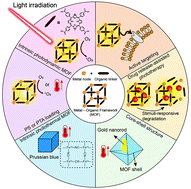The recent progress on metal–organic frameworks for phototherapy
Abstract
Some infectious or malignant diseases such as cancers are seriously threatening the health of human beings all over the world. The commonly used antibiotic therapy cannot effectively treat these diseases within a short time, and also bring about adverse effects such as drug resistance and immune system damage during long-term systemic treatment. Phototherapy is an emerging antibiotic-free strategy to treat these diseases. Upon light irradiation, phototherapeutic agents can generate cytotoxic reactive oxygen species (ROS) or induce a temperature increase, which leads to the death of targeted cells. These two kinds of killing strategies are referred to as photodynamic therapy (PDT) and photothermal therapy (PTT), respectively. So far, many photo-responsive agents have been developed. Among them, the metal–organic framework (MOF) is becoming one of the most promising photo-responsive materials because its structure and chemical compositions can be easily modulated to achieve specific functions. MOFs can have intrinsic photodynamic or photothermal ability under the rational design of MOF construction, or serve as the carrier of therapeutic agents, owing to its tunable porosity. MOFs also provide feasibility for various combined therapies and targeting methods, which improves the efficiency of phototherapy. In this review, we firstly investigated the principles of phototherapy, and comprehensively summarized recent advances of MOF in PDT, PTT and synergistic therapy, from construction to modification. We expect that our demonstration will shed light on the future development of this field, and bring it one step closer to clinical trials.



 Please wait while we load your content...
Please wait while we load your content...